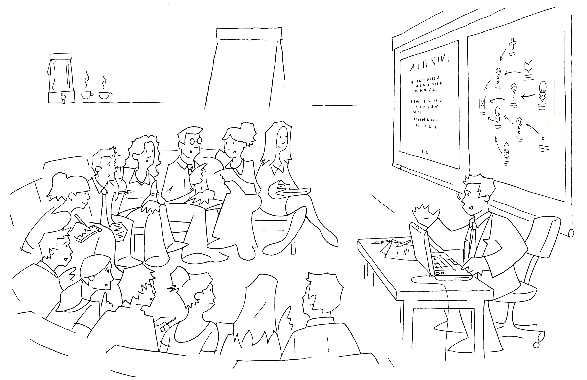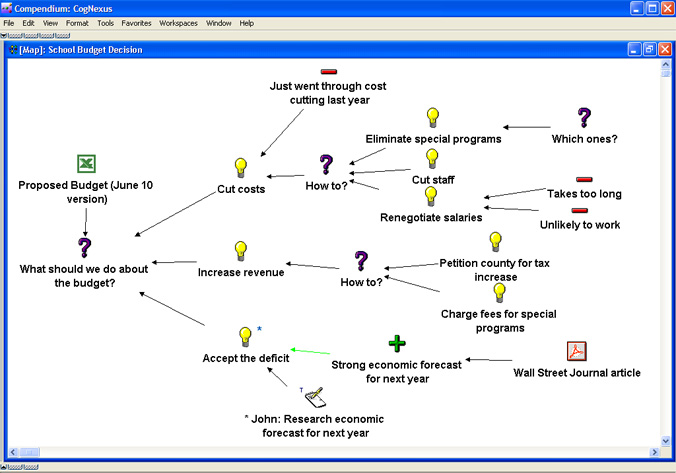We're all familiar with the role of the facilitator. This is the role of the neutral person who plans and guides a group through a meeting, keeping the group on schedule and on topic, and addressing process issues like one person dominating the conversation or group members getting stuck in a debate. The facilitator uses learned skills and intuition to interact with the group in ways that effectively “facilitate” their accomplishment of their meeting objectives.
Dialogue mapping has the same intention as facilitation: to help the group members hold an effective conversation on a complex topic. By “effective” we mean a conversation that both accomplished the objectives and built higher levels of shared understanding, respect, alignment, and transparency. But dialogue mapping uses two tools that are relatively new to the conference room.
|
The first is to capture key elements of the conversation in a shared display. This could be whiteboards or flipcharts, but more often these days it's a computer projector. Shared display means that what is projected in the display is being crafted by the group actively. People's comments are somehow reflected in the display. We're not talking about PowerPoint here!! Sometimes referred to as interactive visual modeling, shared display requires that there be someone driving the computer who has the skills and intention of adding value to the group's interaction and creating group memory of the group's thinking and learning.
The second aspect of dialogue mapping that is new and different is the use of a simple conversational grammar called IBIS, Issue Based Information System. IBIS represents the moves in a conversation as Questions, Ideas (possible answers to the Question), and Arguments (pros and cons to the ideas). The power of IBIS is its emphasis on questions. In an IBIS diagram new questions arise to clarify assumptions, challenge arguments, shift the context, and explore the deeper implications of ideas. Dialogue mapping requires that the mapper be so fluent in IBIS that they can translate everyday meeting-speak (e.g. “Why are we talking about this?”, “That's not the issue!”, etc) on the fly into IBIS and write or type it into the shared display for the group to see and validate. The pinnacle of fluency in IBIS is being able hear the hidden questions behind participants' comments. Here is a simple IBIS map of a complex budgeting issue …
|
It's interesting what happens when a group has a shared dialogue map to interact with during a discussion. As each comment gets captured in the map it becomes clear that listening and understanding each point of view is important. As the conversation goes on there's very little tendency for people to repeat earlier points, and when the discussion starts to cycle someone usually points at the map and says, “I think we've already covered this issue.” Having a few explicit questions in the field of display helps to lower the fog factor and the group tends to stay on topic.
In short, many of the process functions that a facilitator would normally provide come “for free” when the group has a shared display of the key elements of the conversation. As one dialogue mapper observed, “In Dialogue Mapping, we are not attempting to corral participants to speak in `logical order'... for example, we do not say at any point, 'okay, for the next 15 minutes, as a facilitator I only want to hear the pluses and minuses for this particular idea, so that we can complete that section of our diagram.' Instead, a participant might offer a different solution, or a minus to a previous solution, or a different question altogether. The power of dialogue mapping, in my view, is that it allows you to create a linear, ordered display, out of a non-linear, creative process.”
It's still helpful to have someone to watch the clock and make sure that the coffee doesn't run out, but in a simple reflective way dialogue mapping shifts the hardest parts of facilitation to the group members themselves.
|


